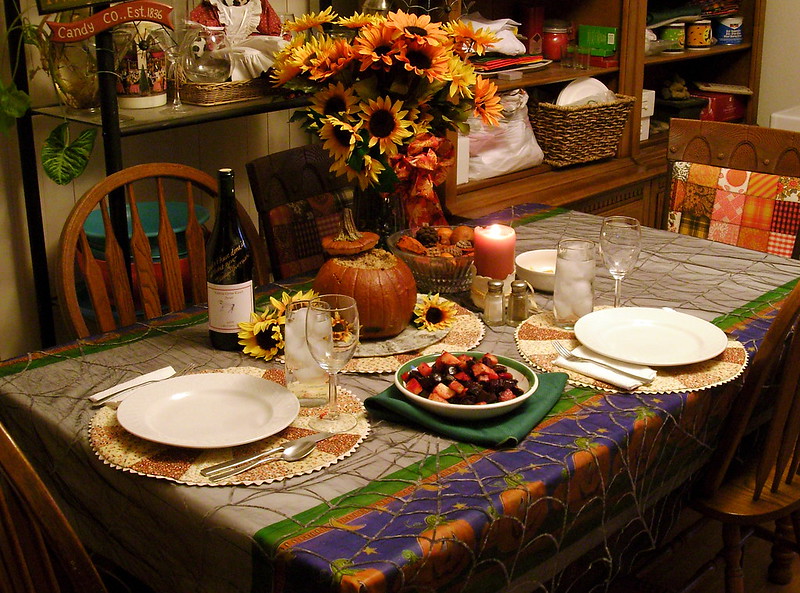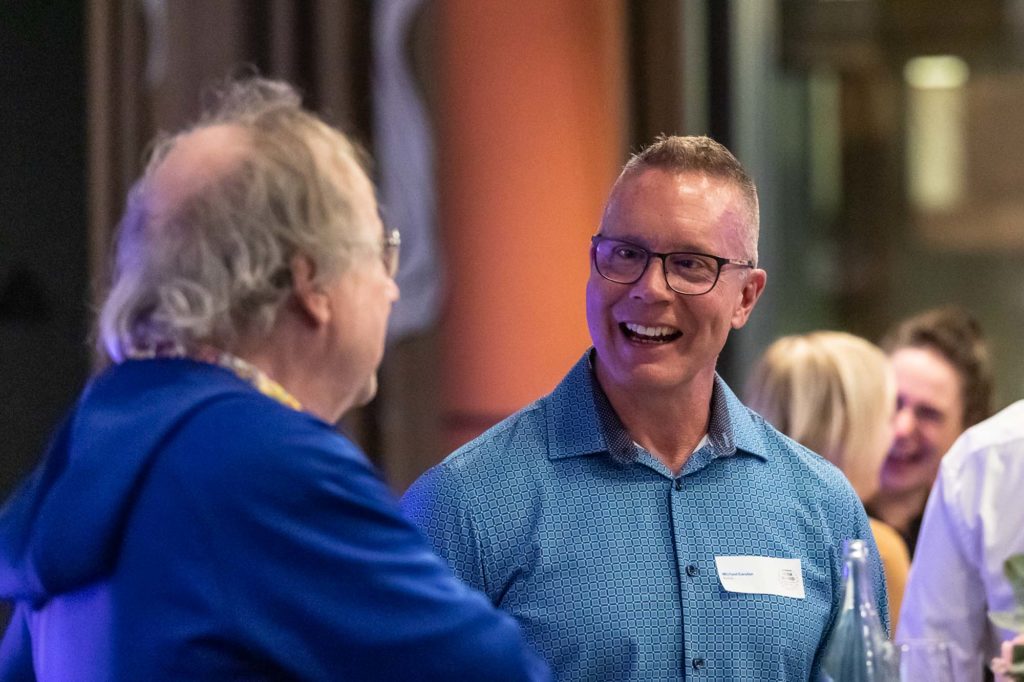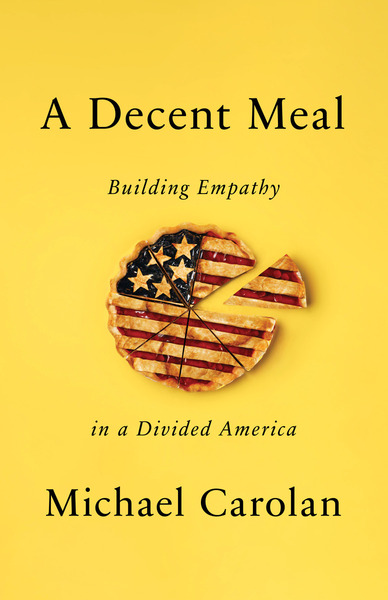
Colorado State University’s new podcast, The Audit, features conversations with CSU faculty on everything from research to current events. Just as auditing a class provides an opportunity to explore a new subject or field, The Audit allows listeners to explore the latest works from the experts at CSU.
As we near the Thanksgiving holiday, some may be feeling a growing sense of joy and togetherness and others may have a sense of impending dread — specifically about all that togetherness. As society’s divides have gotten deeper and more hostile, the Thanksgiving table has become a place where conversations — even among loved ones — can turn ugly.

Colorado State University Sociology Professor and Food Systems Institute Co-director Michael Carolan studies our connection to food and food systems. His latest publication is the 2022 getAbstract International Book Award winning work, A Decent Meal: Building Empathy in a Divided America. In the book, Carolan looks for ways to build empathy in places of common ground — in the fields growing our fruits and vegetables, in the aisles of our supermarkets, and around the dinner table.
Audit host Stacy Nick recently spoke with Carolan to find out more about his research and how food and food systems could be the bridge for a deeply divided country.
I wanted to start with the idea at the center of your book that while most people assume that presenting facts will sway the way the public behaves, it’s when we find places and practices where incivility or even hate is suspended, such as at church or at mealtime, that we can leverage those opportunities into tools for building social cohesion. Now, I know a lot of people who find the dinner table, particularly the Thanksgiving dinner table, to be fraught with political and social landmines. So, I want to push back a little bit on that. Is it really just as easy as breaking bread with someone to find common ground?
The question’s a little bit more complicated than that. In some respects, my book asks the question: “What leads people to actually even want to come to the dinner table to have these types of conversations?” Because if you can find people that are willing to engage in these difficult conversations, then you’re more than halfway there. So, I ask the question: “What leads someone to go from a position of hate and a lack of empathy?” To want to put themselves in those uncomfortable spaces to talk across differences. What I’m really interested in is: What are some of the precursors that lead to those meaningful conversations? The book is really looking at some of those precursors. What are some of the drivers that allow people to be open to differences and have their views changed?
I was really interested in trying to think through how physical encounters themselves — not just facts and information — can disrupt people’s sense of self and their view of the world. And so, I put people in a lot of different situations. One example would be putting people in the context of a community supported agriculture situation. This is an instance where people have the option of being able to work off some of their subscription cost by engaging in physical labor. What’s interesting about these spaces is that they can bring people from very different political and socioeconomic orientations together. You’ll have people who have to work off some of their subscriptions because they can’t afford not to. And at the other end of the continuum, people who are incredibly wealthy, perhaps retired, have time on their hands and who want to – in their words – get their hands dirty and engage with practices that they did when they were younger.
What I found is that when people are in these types of situations and they’re engaging with people that they probably wouldn’t engage with in a normal, everyday situation, the experience itself disarms them in a way that is unusual from many other occasions. They begin to interact with others, and they stop identifying them as a “big D” Democrat or “big R” Republican, left or right, homosexual, heterosexual, by their nationality, by their race or ethnicity. They just begin to have conversations with people. What I found is that food in some of these situations acts as a way to disarm people when they begin to find themselves lost in the encounter and they happen to be alongside others who are very different from them. But as opposed to entering into that situation with an “elbows out,” antagonistic way, they begin to share things that they wouldn’t otherwise share. Through that process, they begin to develop a type of understanding and empathy that I’ve found can be really meaningful in terms of changing attitudes and ultimately behaviors.
What is it about food that seems to be that connecting factor?
 Well, of course, as the saying goes, everybody eats. It’s something we all have in common. One could make the argument that perhaps some cultural events might share similar elements — music and other things. But with food, it’s something we all seem to be very interested in. Food seems to evoke a sense of wonder. I see this in my students too, where people genuinely want to know more about how their food is grown, where it is grown, they want to use it as a way of experiencing different cultural orientations and heritages. It puts people in situations and allows them to engage with others and in ways that maybe other elements may not allow them to engage in. So, it’s very inviting in a way that a lot of other things in our daily lives are not.
Well, of course, as the saying goes, everybody eats. It’s something we all have in common. One could make the argument that perhaps some cultural events might share similar elements — music and other things. But with food, it’s something we all seem to be very interested in. Food seems to evoke a sense of wonder. I see this in my students too, where people genuinely want to know more about how their food is grown, where it is grown, they want to use it as a way of experiencing different cultural orientations and heritages. It puts people in situations and allows them to engage with others and in ways that maybe other elements may not allow them to engage in. So, it’s very inviting in a way that a lot of other things in our daily lives are not.
In one chapter of the book, you brought together liberal progressives with conservative hunters for a meal, and I think listeners can imagine that that was a bit of a powder keg.
Yeah, as I note in the book, the book is about food, but in many ways, it isn’t, either. Really, this is the only chapter that actually involves people sitting around a table and eating, too. In the situation I set up, I invited some of my left-leaning graduate students, who come from a very urban background and have very little exposure to the rural way of life and very little exposure to firearms, to a wild game dinner.
It wasn’t for the point of telling them that they were going to be interacting with people who think very differently from them and to try to get along. We simply went there to eat and the experience itself let them have conversations with people who were not only very different from themselves, but who they would otherwise be very antagonistic toward, and I assume vice versa. It allowed them to have meaningful, interesting conversations that weren’t just around, say, the Second Amendment and guns are good, or guns are bad, or whether or not they kill people. But to talk about what firearms mean culturally from both sides — how they hurt, how they help — and my students left that conversation with a better understanding of why some people cling to firearms and cling to the Second Amendment. There are very real cultural anxieties that are baked into some of those beliefs that because it’s become so politicized, we never get deep enough. We only scratch the surface, and we do not fully understand some of the other cultural motivations that are driving that.
In your book, the chapters follow individuals who participated in experiments ranging from picking strawberries alongside immigrant laborers or attempting to subsist on SNAP benefits. What other shifts in attitudes did you witness?
Well, as you point out with those examples, some of the experiments involve people actually interacting with others that were different from themselves. But they also wanted to try to understand if there were experiences that would allow people to come to some understanding of “otherness” that may not have put them into a room with people who are othered in their minds. The reason for that, too, is you could imagine someone who is openly antagonistic to individuals from other countries who may be undocumented or may be here illegally. There are very real risks, real physical risks, to putting individuals like that in the same room.
So, I tried to also create experiments where people were engaging in the type of labor, for instance, or having the type of experiences that others might have to see if that actually might have some sort of empathetic outcomes that might lead to changes in their views of others. One thing that I find really interesting in some of the research that I was doing, is we often ask the question: What changes attitudes? But we don’t peel back that question and try to think about what some of the precursors to attitudinal change are.
There’s a concept that’s known as metacognition that talks about the process in which we process information. What we know is that people who hold dogmatic views, or are overly confident in their beliefs, are most unlikely to change their attitudes and behaviors. There’s been some research that looks at how we might be able to whittle away at some of that overconfidence and dogmatism and how over time, that actually might lead to substantive attitudinal change.
One way I went about looking at that in the case of people picking strawberries is that I created some websites that were full of information about immigrant labor as it related to industrial strawberry production. I asked individuals at the very beginning of the experiment if they wished to click on the link and review the information. It was part of the initial email I sent to them, and not surprisingly, no one clicked on that link. They then were involved in spending a day picking strawberries and raspberries. Then I resent the link at the end of the experiment and something interesting happened. Quite a few more people — more than half in fact — clicked on the link to learn more about industrial strawberry production. What that tells me is that, whether or not their attitudes have changed, the fact that they were actively willing to click on that link to learn more about industrial strawberry production and immigrant labor told me that from a metacognition standpoint some of that overconfidence and dogmatism might have melted away. That’s also something that I was trying to document as well, not just outright attitudinal change, but trying to measure and get a sense of how people’s willingness to even seek out information might be changed as a result of some of these encounters, as well.
Another thing that you addressed in the book is the urban–rural divide. I’m thinking particularly of the case where you have a group of urban progressive foodies detasseling corn on a farm in Minnesota. How do we build a bridge between the folks growing our food and the populations that they’re feeding?
The rural-urban divide is an interesting question because we’re dealing with populations that are geospatially very distant from each other. One way in which that chapter was inspired is actually an artifact of something that’s being done here at Colorado State University and that I am very proudly a part of. That’s the Extension internship. This was built on a number of years of us recognizing that we have students, a majority coming from urban centers, who’ve had very little interaction with rural communities and rural stakeholders. If they have had interaction, it’s in what we might refer to as amenity-rich rural communities like the Aspens and Vails and Steamboats, which are arguably not representative of a lot of the rural communities that exist in Colorado.
The thought behind the Extension internship was this would be a way for our students to be embedded within rural communities over the course of a summer, working on an identified need that was identified by these communities and by Extension agents embedded within these communities. It would give them exposure to rurality and rural practices there and embedded, while also allowing them to develop professionally and do research in a way that benefits these communities. I think there is a real way in which higher education in particular can think creatively in terms of how we might nurture some of these encounters that allow people to talk across differences that deal not just with race and ethnicity and some of these other issues but can also deal with some of these other cultural divides that center around rurality and urbanality as well.
What was the inspiration for this book and for this project?
I’d say the inspiration from this book is a product of frustration as an educator spending years standing in front of students and professing, because that’s what professors do, about the way the world is and giving them facts and coming out the back end of the semester and not quite believing that I’ve changed any attitudes or behaviors with regard to some of these things. Then I began to incorporate some of these smaller experiences too where I wanted people to have some of these firsthand experiences similar to what maybe students might have done in high school where they’re given a bag of flour or an egg and told to pretend it’s a baby. This is how you’re supposed to experience being a parent, putting yourself in the shoes of a parent or an adult. I wanted to see if there is any truth to that sort of experimentation.
What I learned is that there are problems with putting yourself in others’ shoes. Clearly, if you’re in higher education, if you’re a student at a university, you’re already different from the majority of the population, socioeconomically speaking. But what I find is that there’s also opportunities to grow and learn about others just through some of these relatively simple encounters that I don’t think we give enough attention to. I wanted to explore that more.
Now, not all of us can participate in a sociological study to learn empathy. So, my final question for you is what can folks listening to this do if they want to build greater empathy and understanding either within themselves or in the people around them?
I guess I could answer that in two ways. One way is prescriptive in the sense of what are some of the things that institutions can do to help nurture and afford some of these encounters? There are things that higher education and primary and secondary education could do. There are perhaps programs that could be supported by governments to help encourage the creation of spaces where people from different backgrounds can interact with each other, and in simply just a reexamination of, say, urban planning codes and things like that that would allow for some of these encounters to happen more freely.
I guess at the individual level, I would just recommend for people that are experiencing some of the wonder around food that my students attest to daily is that if you want to learn more about food, if you want to learn how to cook or prepare foods in different ways that come from different nationalities, come from people with different backgrounds, then let yourself be challenged to have those encounters. I think as you satisfy your desire to learn more about food, you might be pleasantly surprised at what else you learn as a result of taking those risks.
How you might help others to experience this would be, first of all, not prefacing it as this would allow you to have an experience with somebody that’s different from yourself from a political and cultural background. But more nudging people in the sense of, you want to learn more about food? Here are some ways in which you can do that. As a result, through those exchanges, they may learn more about themselves and others and through the process, they may rediscover the world in a way that they hadn’t expected.
About The Audit
Recorded at the KCSU studio, Colorado State University’s new podcast, The Audit, features conversations with CSU faculty on everything from research to current events. Just as auditing a class provides an opportunity to explore a new subject or field, The Audit allows listeners to explore the latest works from the experts at CSU.